SHERLOCK HOLMES - COMMON MISBELIEFS ABOUT THE CANON

Authors: Revati and SherlockExtra

Misbeliefs addition
Sadly there are numerous misbeliefs around Conan Doyle’s original Sherlock Holmes stories, which are called the Canon. Here we would like to clarify these.
MISBELIEFS ABOUT THE CANON:
1. Conan Doyle committed murders to get inspiration for his mysteries
This statement is false, of course. Arthur Conan Doyle was a good-hearted man, but many people were jealous because of the huge success of the Holmes stories. These people started to spread misconceptions, hoping to impair or destroy his reputation (or to attract attention and money with false sensationalism). One mean and vicious statement was that the writer murdered to get inspiration for his detective stories.
Heather Owen, who is the member of The Sherlock Holmes Society of London & co-editor of The Sherlock Holmes Journal, refuted this "Conan Doyle committed murders" fake news. Roger Johnson, Commissioning Editor of The Sherlock Holmes Journal also remonstrated against this belief.
We have to note that these accusations spread after Doyle's death, around 1959-1960. Sir Arthur Conan Doyle (1859-1930) has never been charged with murder in his life.
In reality, the writer helped to solve some real crimes, proving the innocence of Oscar Slater, Richard Casement and George Edalji.
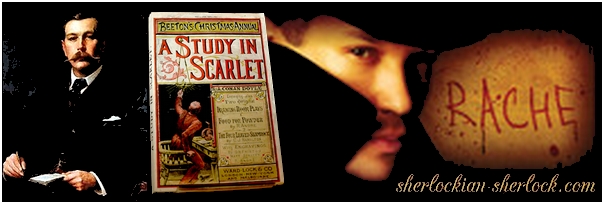
2. Everything in connection with Sherlock Holmes can be called the Canon
Journalists who are not familiar with the world of the Great Detective tend to use the term Canon wrongly. The same occurs with some fans on social media (Facebook, Twitter).
Once Canon meant religious writings that were considered authentic. Later it also referred to literary works that inspired other authors. In this case the works of the original author are sort of protected by the term Canon. This is beneficial, because Canon meant the works of the creative, ingenuous author, and referring to them as that made clear that they were talking about the works of the original author. The author who brought wonders to the world, deserves respect – Sir Arthur Conan Doyle very much deserves it, he inspires others with his masterpieces from the nineteenth century.
The character of the Greatest Detective was so stimulating that people loved to create new things for him as soon as his first adventures had been published. From the beginning of the 1900s the creators of the Sherlockian Game imagined the people who might belong to Sherlock’s family. But it was clear for them that the sleuth and his stories were invented by Conan Doyle. It was important to them to definitely distinguish the original stories and the later, imaginary things. It benefits the fans, and Holmes himself also likes to separate facts from fiction.
Thanks to Doyle’s wonderful ideas and work countless Sherlock adaptations and other literary works could come into being. Ronald Knox (1888 – 1957) and his colleagues began to research the Holmes-related pieces in the Victorian era, and they also started to collect the Canonical works of Doyle.
According to Sherlockian traditions Conan Doyle’s 56 short stories and four novels belong to the Canon. Publishers offer these under the title Sherlock Holmes: The Complete Collection. Sherlockian scholars refer to these in their lectures and publications.
Nowadays the terms Canon and HeadCanon are used in a wider and different sense. It means no problem in some fantasy worlds, but we, the creators of this site would like to be accurate – there are too many adaptations and fanfictions, and our definitions must be clear.
Surely some fans were confused by the fact that Doyle’s Canonical works were published with Benedict Cumberbatch and Martin Freeman on the cover. But the BBC series is not the Canon. The episodes and the characters are based on the original works of the Scottish writer. Conan Doyle wrote the Canon, everything else is fanfiction.
Sherlock’s world is fantastic because his wise fans know exactly what the Canon is. We, the admirers of Holmes can be proud of the fact that our fantasy world is unique and is based on the work of a world famous writer. We have to take care of it. Fans of The Lord of the Rings are also proud of J. R. R. Tolkien’s works and regard them as treasures. We can also consider Doyle’s stories a sort of a bible about the detective.
Unfortunately some people think (and they are wrong) that the word Canon can also be used for modern adaptations (series or contemporary novels). In the Sherlockian world it is clear for a long time that Conan Doyle’s original works are the Canon, and these are the authentic foundations. When we respect this, it means that we are familiar with the Sherlockian traditions and also respect art and our fellow fans. We can avoid misunderstanding, and in a way we continue the valuable work of Ronald Knox, his colleagues and of many Sherlockian scholars. When we meet people who use the term Canon wrongly, correct them politely:
Don't forget:
Sir Arthur Conan Doyle wrote the Canon. EVERYTHING else is fanfiction.
Recommended site:
Wikipedia Canon (fiction)
Contents: Origin + Additional works (1. paragraph - Sherlock Holmes Canon)

3, The modern Sherlock Holmes adaptations are faithful to the Canon of Doyle
Of course we respect the tremendous work what is behind the modern versions, and it is not our task to offer opinion on them – viewers can do that themselves. But the true, the real Sherlock Holmes can only be known from the Canon, from the original stories of Sir Arthur Conan Doyle. Modern adaptations make the detective their title hero, but they change many things in his personality, and he not always profits from these alterings. The situation is the same with the other characters, and unfortunately modern versions contribute to the spreading of numerous misbeliefs as well. The creators of the modern adaptations often sacrifice the detective’s original, humane characteristics and the moral values for being more popular.
Recommended site: Mistakes of the modern Sherlock Holmes adaptations
4. Conan Doyle committed plagiarism
a, Conan Doyle plagiarized the story of The Hound of the Baskervilles
Doyle and his friend Bertram Fletcher Robinson were golfing together, when the latter told a tale about a phantom hound in Dartmoor, where he had lived. They decided to write a story about it together. Doyle travelled to Robinson’s house and they completed the adventure. While being in Dartmoor, Doyle even wrote to his editor about the new project, and he stated in the letter: „I must do it with my friend Robinson and his name must appear with mine.” But the story appeared under his name, only with a footnote, telling „This story owes its inception to my friend, Mr. Fletcher Robinson, who has helped me both in the general plot and in the local details.”He also paid his friend 500 pounds.
To add to the confusion, Doyle later wrote: „The plot and every word of the actual narrative are my own.” The Hound of the Baskervilles was published in 1902. Sir Arthur Conan Doyle died in 1930. In 1959 - according to other sources in 1960 - Henry Baskerville, who was Robinson’s coachman, told in an interview that he had seen him, and not Doyle, writing large sections of the novel.
It should be mentioned that at the time of writing Conan was already a world-famous writer. He brought innovations to literature and criminology that no one had done before. He was not short of ideas. Although he had already killed Sherlock Holmes, but his fame would not have been diminished if he had collaborated with another artist. Doyle was a true artist who respected the work of other artists. The two friends may have once planned the story together, but Doyle ended up writing it alone, with a different plot. Remember that readers, his own mother and the brilliant actor Willam Gillette had also convinced him before the story was published that he should resurrect Sherlock, so Doyle could go his separate ways with new inspiration. Conan was a gentleman. Perhaps he paid Robinson a debt of gratitude for mentioning the legend that inspired him.
b, Harry Houdini also said that Doyle committed plagiarism
There is an interesting story related to this: The famous illusionist, Harry Houdini accused Arthur Conan Doyle with plagiary.
Houdini, who was a close friend of Doyle for some time, knew every trick from the world of jugglery. Nowadays plagiary means someone using the work of someone else as his/her own. Doyle was a really talented writer, he did not need to copy the work of others. He changed a lot in the story of Poe, and invented new characters. In ancient times Romans took over the names and sculptures of Greek gods, and they still could make new sculptures and gods. Both the Greek and the Roman mythology are important parts of the culture. In the same way are both the works of Poe and Conan Doyle integral parts of literature.
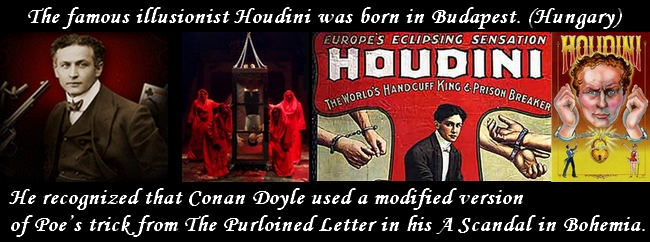
By all means we have to nail down that the Houdini plagiary does not refer to monotonous copying. It means that the famous magician recognized that Conan Doyle used a modified version of Poe’s trick from The Purloined Letter in his A Scandal in Bohemia. Doyle changed many details in his story, and all the characters and events were his creations. In the adventure the letter had been changed to a photograph, and he masterfully made possible for Holmes to wear one of his many disguises. Houdini never put Doyle's writing talent into question. As an artist and magician, he was rightfully vain and proud of his tricks. He only pointed out that the author based a story upon a famous magic trick.
Sir Arthur Conan Doyle was a very prolific writer, he penned many non-Sherlock stories. His The Lost World became an inspiration for lots of books and adaptations. His historical works are also outstanding. He was a truly ingenuous, productive writer. His books prove that he never needed plagiary.

HUNGARIAN MISBELIEFS (OR RATHER ERRORS)
5. Conan Doyle wrote 60 Sherlock Holmes stories and two novels
The Sign of Four had also been published in Hungary under the title The Dilettante Detective. The online description of the book says wrongly that Doyle wrote 60 short stories and two novels. The writer had 56 short stories and 4 novels (the novels being A Study in Scarlet, The Sign of Four, The Hound of the Baskervilles and The Valley of Fear).
The Hungarian Sherlock Holmes Canon doesn't include Doyle's Watson Learns a Trick and The Field Bazaar, because they are not crime stories. (You can read the omitted stories in Hungarian on the Hungarian Sherlock Holmes Club blog.)
6. Sherlock Holmes and ’The Musgrave Virus’
Some years ago The Adventure of the Musgrave Ritual was listed in a Hungarian TV-guide as The Musgrave Virus. This is a misbelief based upon mishearing and being not familiar with the stories. The legendary sleuth had nothing to do with viruses. The explanation lies in the similarity of the Hungarian words rítus (meaning ritual) and vírus (meaning virus, disease). Musgrave was the family name of Sir Reginald, whose butler disappeared while Holmes was on vacation on the estate.
7. Doyle’s detective had an investigation at a place with a dreadful name
Another failure in a Hungarian TV-guide. There’s a story entitled The Adventure of the Copper Beeches. The Hungarian name of this type of tree (Fagus sylvatica ’Purpurea’) is vérbükk (vér means blood, that refers to the colour of the tree’s leaves, while bükk means beech). Probably a translator was not familiar with the Canon, and because of the genre (crime/detective story) the word bükk had been substituted with the better suiting word bűn (crime): Vérbükk => vérbűn
Authors: Revati & SherlockExtra - Translator: Revati
© All rights reserved.
Sherlockian-sherlock.com "exciting and important website"
Mr. Roger Johnson, The Sherlock Holmes Society of London
Press and Publicity Officer and Hon Editor
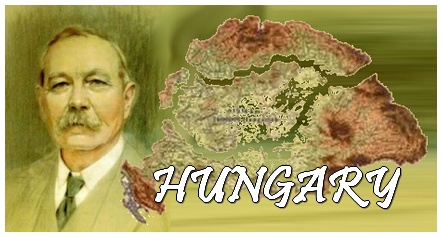
Hungarian references in the life and works of Conan Doyle
Sir Arthur Conan Doyle and Hungary

We used this nice Conan Doyle drawing for the header:
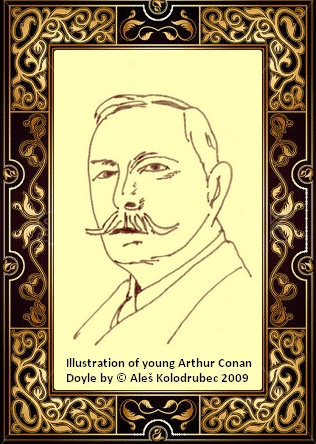
Mr. Aleš Kolodrubec, the president of
the Czech Sherlock Holmes Society
allowed us to publish his drawing.

Recommended article:
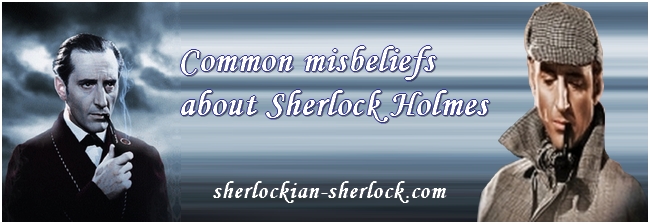
Common misbeliefs about Sherlock Holmes

Keywords: Sir Arthur Conan Doyle, Sherlock Holmes Complete Canon,
original stories, book, shot stories, detective, crime, sherlockian, mysteries,
common Sherlock Holmes misbeliefs, mistakes, plagiarism, BBC Sherlock,
BBC Sherlock series, Stephen Moffat, Mark Gatiss, Martin Freeman, fake news,
fake, facts, Benedict Cumberbatch, TV-guide, Sherlock original stories, novels,
HeadCanon, fans, Harry Houdini, fan, false, modern adaptations, faithful to the Canon

|












